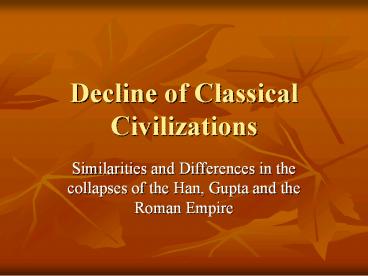Decline of Classical Civilizations - PowerPoint PPT Presentation
1 / 11
Title:
Decline of Classical Civilizations
Description:
Civil war occurred increased protest When the Xiongnu Huns invaded, ... (moved into Europe as a result of Huns) which part of the empire was more unprotected? – PowerPoint PPT presentation
Number of Views:102
Avg rating:3.0/5.0
Title: Decline of Classical Civilizations
1
Decline of Classical Civilizations
- Similarities and Differences in the collapses of
the Han, Gupta and the Roman Empire
2
Similarities in Decline
- A combination of internal weakness and invasion
- Between 200 and 600CE, all 3 classical civs
collapsed entirely or in part - During the 400 years, all 3 were invaded by the
pastoral nomads in Central Asia known as the
Asiatic Huns - All 3 civs had problems politically long before
invaders affected them (Rome and Han suffered
from serious internal problems and Guptas were
dealing with regionalism)
3
(No Transcript)
4
The Decline of Han China
- By 100 CE, Confucianism was losing its influence
among the bureaucrats ? corruption increased - Local landlords began to gain power ruling their
lands as they wished ?became less centralized - Peasants already heavily taxed were burdened with
new taxes and increasing demands of the
landlords many became day laborers on large
estates some sold children into slavery - Daoism overshadowed Confucianismwhy? Impact?
- Civil war occurred ? increased protest
- When the Xiongnu Huns invaded, the dynasty was
already too weak to defend itself - Han collapsed in 220 CE
5
Aftermath of Han Collapse
- Epidemics killed nearly half the population and
the weak govt of the next dynasty was NOT doing
enough to remedy the situation - Regional rule and weak dynasties rose and
fellsignificance? - Cultural unity was threatened as Buddhism (a
foreign religion) spread and practicedwhy would
people embrace this religion? - This nearly 400 years of instability is known as
the Era of Division or the Era of Six Dynasties
(220 -589) the Sui Dynasty would revive China
from 589-618 and then the Tang in 618 brought
back glories of Hanmeaning? - All in all, there was NO permanent disruption!
The classical structure of China was too strong
to be overturned what remained, although
weakened for a while, was the bureaucracy,
Confucianism dynastic cycle and mandate of
heaven. The Xiongnu eventually assimilated.
6
The Decline of Gupta India
- The decline of India was less drastic than Han
China only because India is not known for its
strong unifying politics - By the 5th century, Gupta leaders were having
trouble controlling regional princes - By 500 CE, the White Huns were invading Northern
India the empire collapsed in 535 CE
7
Aftermath of Gupta Collapse
- As in China, the White Huns assimilated in Indi
- What religion would they convert to?
- became part of Kshatriya Caste)
- For several centuries, no native ruler was able
to build a large centralized state - Achievements in science and math declined as well
as the economy - Even after collapse, many continuities existed
- regionalism lasted for many centuries
- Buddhism continued to decline in India
- Hinduism remained the dominant religion
- caste system still helped define the political,
economic and social way of life - Tamil kingdom continued to have strong merchant
activity
8
Decline of the Roman Empire
- More disruptive than the two Asian Classical
Empires - Decay occurred after 180 CEwhy?
- Weak emperors ruled fairly consistently until
collapse in 476 - Plagues swept over the empirehow come China and
Rome were both affected? - The population decreased from 1 million to
250,000 - Hard to recruit troops for Legion (army)
- Germanic soldiers were hired to guard
frontierwere they loyal? - Romes upper classes became lazy and consumed by
pleasureimpact on bureaucracy and economy? - Little to no innovation in science, math, arts
and literature - Farmers turned to large landholders for
protection which began decentralization and the
beginnings of self-sufficiency
9
Two Emperors who tried really hard to bring back
Rome
- Diocletian (284-305)
- Attempted to reform administration and tax
collecting - Divided the empire into West and Eastwhy?
- Insisted on being worshipped as a god to
strengthen power of govtwhat is the effect?
- Constantine (312-337)
- Set up a second capital at Constantinopleimpact?
- Edict of Milan in 313impact?
10
The Final Years of Rome
- Dividing the empire made the west weakness worse
- Legion deteriorated further
- Germanic invasions occurred in the 400s (moved
into Europe as a result of Huns)which part of
the empire was more unprotected? - Germanic Kingdoms were established in 425 and the
last Roman Emperor was dethroned in 476
11
Aftermath of Fall of Rome
- Romes fall split the unity of the Mediterranean
lands - Rome did not establish as strong of a
bureaucratic tradition that China had nor had
Rome created a unified belief system that could
unify people enough (Christianity was embraced
too late)these reasons were why Romes fall was
more permanent than India and China - The Eastern part, centered in Constantinople was
a continuity and did not fallwent on to become
the Byzantine Empire that would last for another
1000 years collapsing in 1453 and carrying on the
legacy of preserving Greco-Roman culturewho was
the Byzantine ruler that preserved Roman law? - The Western portion of Rome (Italy, Spain and
points north) was where the empire collapsed - There was actually a reduced level of
civilization after 476 in the WEST crude
regional kingdoms developed, cities shrank and
trade almost disappeared, the west became
DECENTRLIZED under feudalism and manorialism.
BIG CONTINUITIES! - Christianity was the only source of unity found
throughout Europe and would remain that way for
several more centuries

